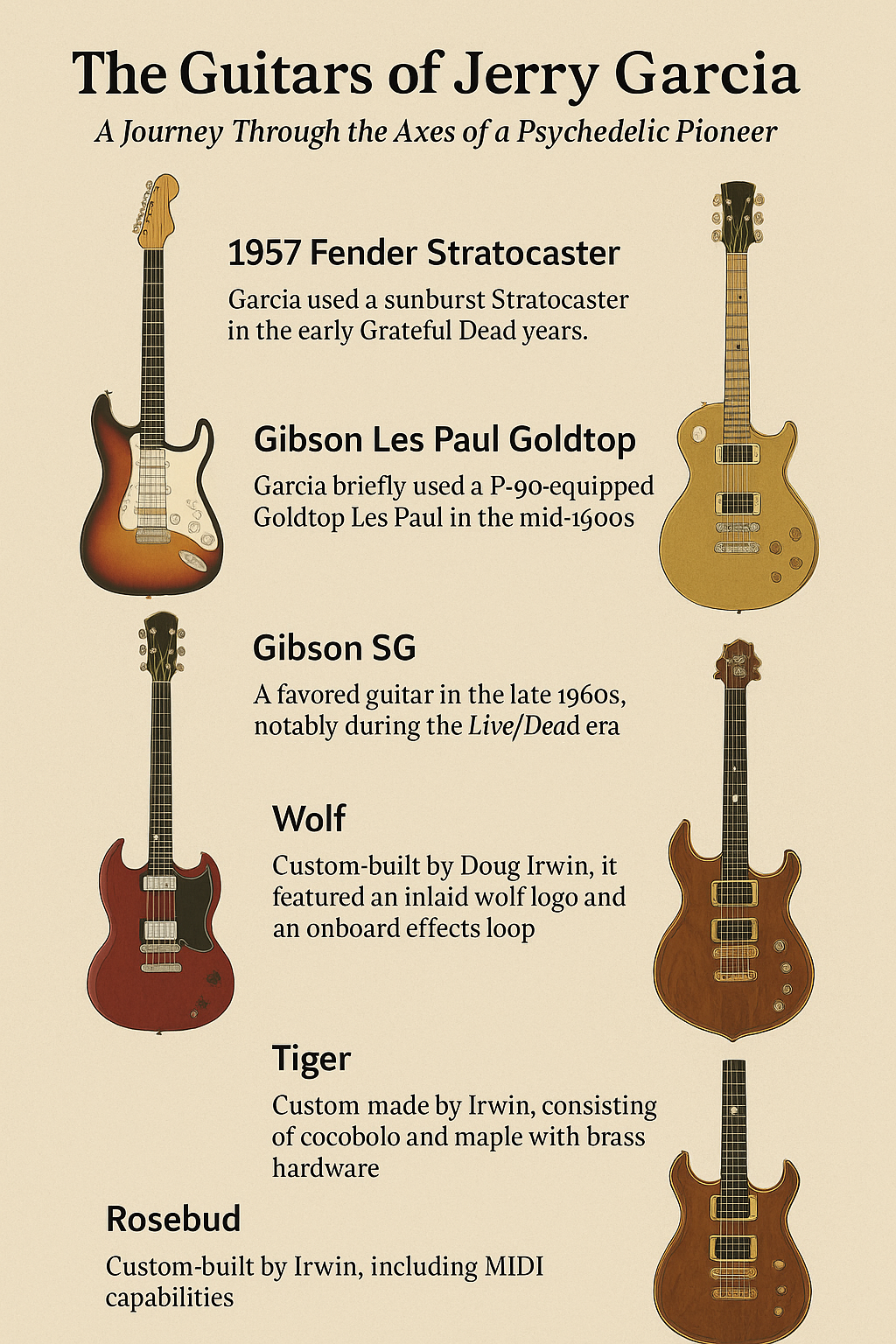Jerry Garcia was not only the lead guitarist and spiritual compass of the Grateful Dead — he was also a gearhead in the truest sense. Over his decades-long career, Garcia used a wide range of guitars, often customised to meet his exacting tonal and ergonomic standards. From off-the-shelf models to groundbreaking custom builds, each guitar played a role in shaping the signature sound of the Dead.
Early Days: Gibsons and Fenders
In the early 1960s, Garcia played a number of stock instruments, including:
-
1957 Fender Stratocaster – Garcia used a sunburst Stratocaster in the early Grateful Dead years. It provided the brightness and clarity that suited the band’s exploratory soundscapes.
-
Gibson Les Paul Goldtop – Garcia briefly used a P-90-equipped Goldtop Les Paul in the mid-1960s. Its warm, punchy tone was an early favourite, though he soon moved on in search of greater tonal variety.
-
Gibson SG – A favoured guitar in the late 1960s, notably during the Live/Dead and Workingman’s Dead era, offering sustain and access to higher frets.
The Alembic Era: Customisation Begins
In the early 1970s, Garcia partnered with Alembic, a pioneering San Francisco–based instrument maker that emphasised high-end electronics and modular design.
-
“The Peanut” – A heavily modified Gibson SG-style body fitted with Alembic electronics. It served as a testing ground for new ideas.
-
Alembic 001 – One of Alembic’s first true custom guitars, featuring active electronics and advanced filtering systems, though it was heavy and not ergonomically ideal.
Enter Doug Irwin: Wolf, Tiger, and Rosebud
Garcia’s most iconic instruments came from Doug Irwin, who crafted guitars to match Jerry’s evolving style and technological desires.
-
Wolf (1973–1979, 1987)
Custom-built by Irwin, Wolf featured a set-neck design, inlaid wolf logo, and onboard effects loop. It became Garcia’s primary instrument during the Dead’s most exploratory years, including Europe ’72 and Blues for Allah.
-
Tiger (1979–1989)
Perhaps Garcia’s most beloved guitar, Tiger was made from cocobolo and maple with brass hardware and a complex electronics system including coil taps, OBEL (onboard effects loop), and multiple pickup selections. It served as his main guitar longer than any other.
-
Rosebud (1990–1995)
Similar in design to Tiger but lighter, Rosebud included MIDI capabilities, allowing Garcia to trigger synthesizers and explore new sonic realms during the band’s later years.
The MIDI Years: Expanding the Sonic Palette
By the late 1980s, Garcia integrated Roland GK-series MIDI pickups into his guitars, particularly with Rosebud and later Lightning Bolt, allowing him to control a range of synth tones and textures. This technology added new dimensions to the Dead’s already expansive live sound.
Later Builds: Lightning Bolt and Top Hat
-
Lightning Bolt (1995) – Built by Stephen Cripe after Irwin stopped building guitars, this cocobolo guitar was lighter than Tiger and Rosebud, with streamlined electronics and the signature OBEL.
-
Top Hat (aka “Cripe #2”) – Garcia used this occasionally in 1995, marking the final chapter in his guitar evolution.
Conclusion
Jerry Garcia’s guitar journey mirrors his relentless pursuit of musical exploration. Each instrument — whether a humble Strat or a technologically advanced custom Irwin — was a vehicle for pushing the boundaries of improvisation and tone. Today, these guitars are as legendary as the music they helped create, forever intertwined with the mythos of the Grateful Dead.









